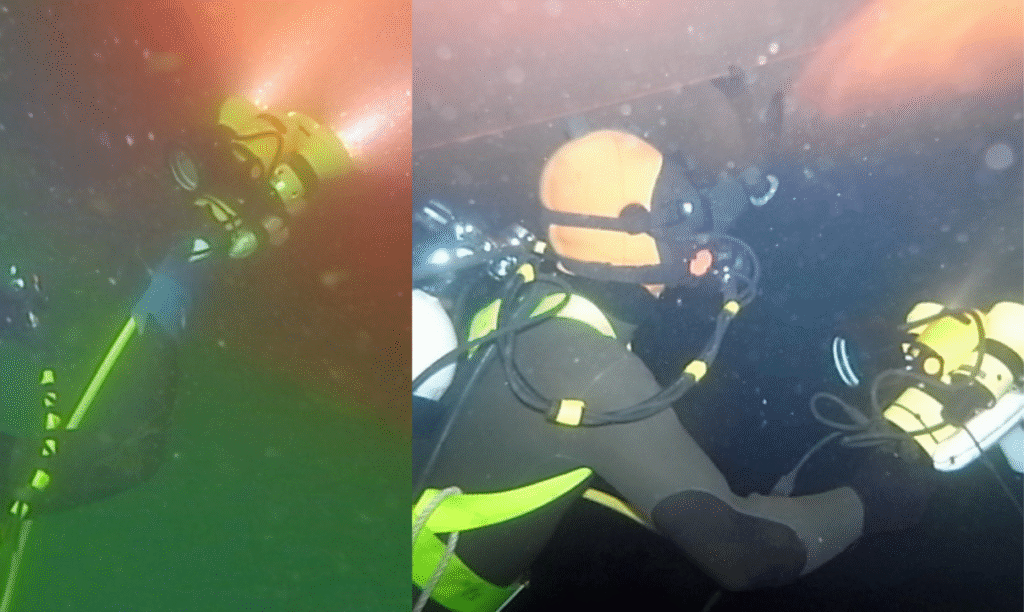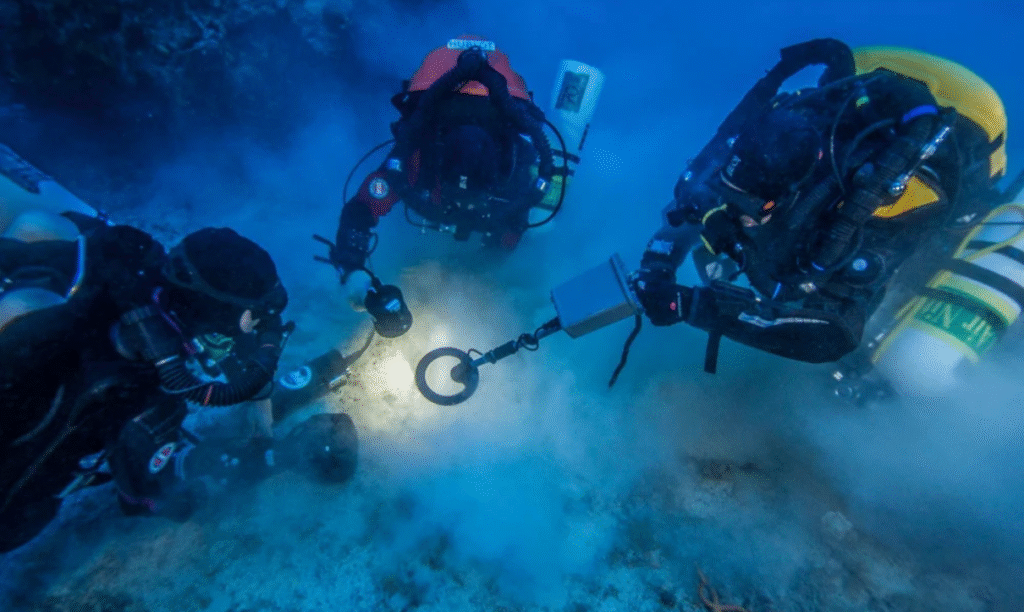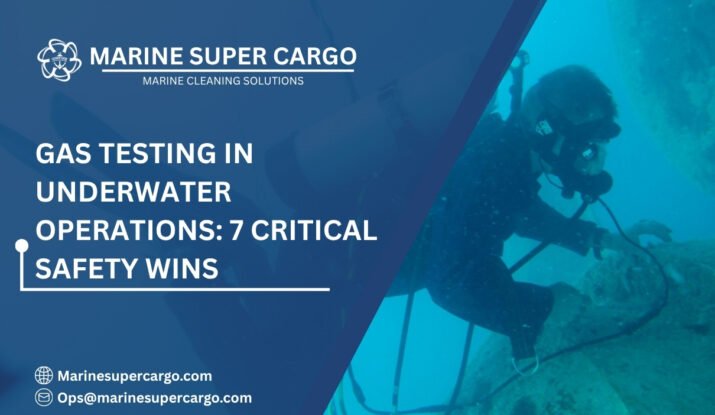When you think of underwater operations, images of divers, remotely operated vehicles (ROVs), and silent, high-pressure environments probably come to mind. But beneath this almost cinematic picture lies a critical—yet often overlooked—safety shield: Gas Testing in Underwater Operations. Without it, offshore and subsea activities risk turning into silent disasters waiting to happen.
In this guide, we’ll explore why Gas Testing in Underwater Operations isn’t just another box to tick for compliance. Instead, it’s your frontline defense against toxic hazards, explosions, and costly delays. And if you’re a ship owner, operator, or manager, this isn’t just about safety—it’s also about protecting your bottom line, your crew, and your reputation. By prioritizing Gas Testing in Underwater Operations, you ensure smarter decisions, stronger compliance, and a safer future for maritime operations.
Why Gas Testing in Underwater Operations Matters
Underwater worksites present unique dangers you won’t find in land-based industries. Picture a diver entering a ballast tank or an ROV inspecting a subsea pipeline. At first glance, everything looks controlled. Yet, an invisible cocktail of gases like oxygen-deficient air, flammable vapors, or hydrogen sulfide (H₂S) could threaten lives within seconds.
Gas testing in underwater operations ensures that these invisible killers are identified, monitored, and controlled before catastrophe strikes.
Here’s what it protects you from:
- Toxic gases such as H₂S, carbon monoxide, or chlorine.
- Explosive atmospheres from hydrocarbon vapors or methane.
- Asphyxiation hazards in low-oxygen environments.
- Environmental fines for compliance failures under IMO or MARPOL standards.
Think of gas testing as your underwater flashlight—it reveals what your eyes and ears can’t detect.

Common Hazards in Underwater Worksites
Gas testing plays a decisive role because the ocean is not a forgiving environment. Take confined space entry underwater as an example. Tanks, cofferdams, and subsea storage facilities may trap gases, creating an unpredictable ticking clock.
Some key hazards include:
- Oxygen deficiency: Levels below 19.5% severely impair consciousness.
- Methane leaks: Dangerous even in trace amounts due to explosiveness.
- Hydrogen sulfide: Fatal in concentrations as low as 700 ppm.
- Nitrogen buildup from inert gas systems: Silent asphyxiation risk.
Compliance bodies like the International Marine Contractors Association (IMCA) stress that these risks must not be underestimated. IMCA guidelines underline continuous monitoring as a must—not a luxury.
How Gas Testing in Underwater Operations Works
Gas testing is not a one-off exercise but a carefully structured process. To simplify, imagine it as four phases:
- Pre-entry testing
Conducted before divers or ROVs enter confined underwater spaces. Portable detectors measure oxygen levels and identify toxic and flammable gases. - Continuous monitoring
Just because the atmosphere was safe at the start doesn’t mean it stays that way. Ongoing sampling ensures dangerous buildups are caught in real time. - Alarm and control systems
Modern detectors are linked with alarms that trigger evacuation or ventilation when thresholds spike. - Post-operation testing
Ensures the area remains stable for future use and confirms successful hazard control.
This creates a proactive circle of safety—and reduces liability exposure for operators.
Tools and Techniques for Gas Testing
Gas testing in underwater operations requires a combination of advanced technology and robust practices.
- Multi-gas detectors: Compact, portable devices capable of measuring up to 6 gases simultaneously.
- Fixed monitoring systems: Installed in subsea habitats or tanks for continuous real-time oversight.
- Sampling pumps: Pull gases from hard-to-reach areas where direct measurement is impossible.
- Remote tools: Linked with ROVs that penetrate areas unsafe for divers.
One interesting innovation is the rise of wireless sensor networks in diving operations. These allow data to be transmitted topside instantly, giving supervisors live situational awareness.
✅ 4 Things to Check for Safety at Sea pic.twitter.com/dAxhJQ2i6U
— Marine Super Cargo (@Marinsupercargo) September 14, 2025
Regulatory Frameworks You Can’t Ignore
Ignoring gas testing isn’t just unsafe—it invites legal trouble. The International Maritime Organization (IMO) and the MARPOL Convention highlight strict compliance requirements for ship operations, including the management of hazardous atmospheres.
- IMCA D 022: Lays down diving safety protocols, including atmosphere monitoring.
- MARPOL Annex VI: Covers air pollution and emissions that could affect shipboard and underwater environments.
- Port authority rules (IAPH guidelines): Increasingly focus on sustainable, safe practices for global ports.
Being proactive in gas testing aligns not just with regulations but also with ESG goals, reducing harmful emissions and improving sustainability scores—a growing concern for charterers and regulators alike.
Cost of Neglect vs. Cost of Compliance
Let’s bring this closer to your realities as owners and operators:
- Accident costs: Medical bills, lawsuits, downtime, and possible vessel detention.
- Cleanup costs: Environmental remediation after toxic gas leaks.
- Insurance premiums: These spike after safety incidents, hurting your P&L.
- Reputation costs: A single safety lapse makes stakeholders question your reliability.
Investing in gas testing in underwater operations might seem expensive upfront, but it actually saves money by preventing catastrophic costs down the line.
Think of it as buying a safety net before walking a tightrope—you rarely regret the investment when the stakes are this high.
Best Practices for Effective Gas Testing
- Train your crew: Equipment is only as good as the people using it.
- Calibrate regularly: Uncalibrated detectors give a false sense of security.
- Integrate with permits: Every confined space entry permit should mandate gas testing.
- Document everything: Regulatory audits require hard evidence of safety management.
- Go beyond minimums: Don’t just comply—strive for industry best practice.
A strong safety culture isn’t built overnight, but gas monitoring is one of its strongest pillars.
Case Studies: When Gas Testing Saved Lives
- A subsea maintenance project off the coast of Norway detected methane buildup in time, preventing a catastrophic explosion near divers.
- In Singapore, ballast tank entry was delayed after testing revealed oxygen deficiency. The delay saved two workers’ lives when ventilation corrected the risk.
- A salvage team in the Gulf of Mexico avoided fatalities by detecting hydrogen sulfide before diver deployment.
Each case reinforces a simple truth: gas testing in underwater operations is not optional—it’s lifesaving.

Future of Gas Testing in Underwater Operations
Technology is pushing monitoring into exciting frontiers. Expect to see:
- AI-driven predictive analytics that detect dangerous gas buildups before they occur.
- Real-time fiber optic sensors integrated into subsea pipelines.
- Smart helmets for divers with built-in gas monitoring displays.
- Green compliance tools that align with decarbonization goals and IMO’s push for sustainable operations.
The future isn’t just about safety—it’s also about smarter compliance and efficiency.
Conclusion
Safety underwater is never just about what you see. The hidden threats are often the most dangerous. Gas testing in underwater operations provides three essential benefits:
- It protects lives by identifying invisible hazards.
- It ensures compliance with international standards like IMO, IMCA, and MARPOL.
- It saves costs by preventing accidents, penalties, and reputation damage.
If you’re ready to align safety with efficiency, start making gas testing a central pillar of your underwater projects. For expert support and sustainable solutions, visit CleanShip.co today.
FAQs:
Q1. What gases are most dangerous in underwater operations?
Hydrogen sulfide, methane, carbon monoxide, and oxygen deficiency pose the greatest risks during underwater tasks.
Q2. Is gas testing required by law in marine industries?
Yes. IMO, IMCA, and port authority rules mandate continuous monitoring in confined spaces and underwater worksites.
Q3. How often should gas testing be done in underwater projects?
Testing should be conducted before, during, and after operations, with continuous monitoring in confined atmospheres.
Q4. What tools are used for gas testing underwater?
Operators rely on portable multi-gas detectors, fixed monitoring systems, sampling pumps, and ROV-compatible tools.
Q5. How does gas testing support ESG and sustainability goals?
By reducing emissions, preventing leaks, and ensuring compliance with MARPOL standards, gas testing enhances environmental responsibility.


